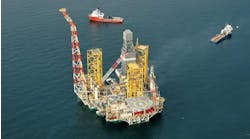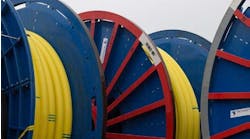Leonard LeBlanc
Houston
Deepworker 2000.
Will pumpdown instruments revolutionize production monitoring?
Conventionally, bottomhole production instrumentation cables are run alongside and attached to production tubing, but new methods may allow instruments to be pumped down inside tubing using thin shielded fiber optic cable. Various methods are being examined now and more are on the drawing board.
The instrument package and cable are pumped down the production tubing and remain there during production. The package and cable can be removed without pulling the tubing.
Periodic replacement would involve a downhole release - production back-pressure, a signal to the attachment device, or sufficient pull on the cable. The cable and package can be snubbed into a sealed launching tube at the wellhead and removed. One concern is cable wear from produced sand and vibration as a result of multiphase production.
BP identifies five critical advances
British Petroleum identified five technical innovations that are expected to greatly improve the costs picture on small and mature reservoirs in a London conference recently. They are:
- Wellhead processing: Processing of production streams at the wellhead or downhole (reduced flow) eliminates the handling of water through a riser or topside, allowing re-injection of water in depleted zones downhole.
- 4-D seismic: Monitoring reservoir behavior and imaging fluids with periodic 3-D seismic surveys, with or without fixed instruments, helps in planning for changes in reservoir and production behavior.
- Multiphase metering: Being able to measure flows of unseparated phases (liquids and gases) at the wellhead aids in the automatic adjustment of production processes and eventually seabed separation of phases.
- Multilateral completions: Branching wells from a vertical borehole with pressure-tight connections help provide better reservoir drainage and eliminate additional wells.
- Fracture simulation: New techniques that simulate the producing zones, especially tight reservoirs, and the impact of fracturing will improve the design of fracturing operations and the resulting production flows.
Methane cycling may have greater impact on climate, oceans
Could methane be a major controlling factor in global climate change? The global proportions of methane - as a gas, a hydrate, converted to carbon dioxide, and tied up as carbon in the earth's sediments - may prove to have greater impact on the earth's climate than anything else.
Methane gas is generated by heat and pressure in two carbonaceous systems - deeply buried sediments and subducted sediments. As the generated methane migrates to the surface, it is released in two forms depending on temperature:
1. If the earth is relatively cold or the oceans deep, the methane will tie up with water and deposit as a hydrate at the seabed or under permafrost.
2. If the earth is warmer, methane will emerge as a gas, enter the atmosphere, and convert to carbon dioxide in the presence of oxygen and solar radiation.
This methane cycle, also known in some respects as the carbon cycle, appears to operate in the following manner: As the earth warms, the polar ice melts and raises sea levels. The permafrost hydrates melt, while at the same time, more hydrates form as the sea levels rise. The net result seems to be an apparent tie-up of more methane as hydrates and falling carbon dioxide levels, but that observation is arguable.
As carbon dioxide is removed from the atmosphere, the heat trap around the earth dissolves and the earth cools, which produces ice at the poles and lowers the sea level. As sea levels drop, the vast sheets of methane hydrate under the world's oceans melt, releasing huge quantities of methane to the atmosphere, which then boost carbon dioxide levels, and the entire global warming cycle is repeated.
Alternate cooling and warming of the planet generally is attributed to sun cycles and the earth's position relative to the sun, but methane cycling could accelerate or deepen warming and cooling trends. These extremes, in turn, could cause catastrophic climatic events. For example, massive simultaneous conversions of methane hydrate to methane gas could push global temperatures up very quickly, altering rainfall patterns, oceanic circulation, and agricultural systems.
Other than calculating changes in mass balance of methane forms and carbon dioxide, science has little way of determining the position or direction of a cycle. In general, there are some modest indicators: permafrost layers appear to be thinning, sea levels are rising slightly, and the global air temperature may be slightly higher. Whether these conditions are simply climatic mini-cycles or general warming may not be determined for some years to come, and defining the role of methane cycling may be even more remote.
Manned tetherless vehicle provides support at 3,000 ft depths
Seeking to avoid the water depth - larger umbilical - bigger ROV/more power - larger umbilical upgrade spiral, Nuytco Research (Dr. Phil Nuytten) of Vancouver, Canada has developed the manned Deepworker 2000. The vehicle operates without a tether and can dive to 3,000 ft depths.
Although many one-atmosphere manned submersibles or diving suits have preceded this unit, the Deepworker is apparently the first ROV-sized unit to operate tetherless. The design seeks to combine the intelligence of an onsite operator with the versatility of an untethered remotely operated work vehicle. Conventional manned submersibles and suits have umbilical supports, which can become tangled in deepwater operations. On the other extreme, an unmanned untethered vehicle has difficulty carrying out multiple tasks and transmitting video or receiving audio from surface control.
The Deepworker 2000 consists of a plexiglass sphere joined to a short cylinder and a pair of battery pods. Attached to the front are dual manipulator arms. The operator sits in the sphere and operates the arms. Foot pedals control all of the thruster powered motions of the vehicle. The manipulator arms use seawater hydraulics. The unit provides a variety of acoustic signals to the surface launch-recovery vessel for location purposes and emergencies. The unit has a four-day life support capability.
Cranfield simulates 5,000 ft deep weld
A plasma weld was successfully executed inside a hyperbaric chamber at Cranfield University in the UK that simulated a water depth of 5,000 ft. The Marine Technology Centre, allied with Stansted Fluid Power, initiated the arc and conducted a stable welding process, which resulted in a weld bead of acceptable appearance. The hyperbaric chamber was pressurized to 150 bars for the test and will be able to reach 250 bars when fully upgraded.
Copyright 1997 Oil & Gas Journal. All Rights Reserved.


